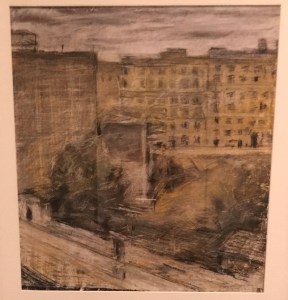The Museo del Novocento’s exhibition, Margherita Sarfatti, reflected the gravity and passion that she poured into her causes – her attempts to influence a ‘national expression of the arts’ and to position Milan as the centre of artistic opinion and critique.
What the exhibits illustrated was a time in Milan when the city’s inhabitants and bureaucrats were in the process of defining the features that would go on to give the city its reputation as a powerful artistic and industrial centre.
The display included works from private collections including Mario Sironi (1885-1961), one of Sarfatti’s favourite artists. Passaggio urbano, 1908 documents the new tenement buildings that were rising up in the city and as I wander around areas along via Michelangelo Buonarroti, I see modern versions of these still.
The exhibition continued to express the urban theme of modern Milan with scenes of streets, automobiles, trains and air travel.
As well as portraits of Sarfatti and display cases of magazine articles penned by her, other works reflected the outward contemplation of progress and modernity, such as a portrait of a woman wearing the latest fashion ensemble, paintings of social settings and of a group of women sitting around a table, not depicted as part of a domestic scene, but as if they were discussing current affairs.
 New to me was the manner in which Italian artists, after World War 1, returned to and represented the classical form. This work by Mario Sironi (Nudo con fruittiera – Nude with Fruit Bowl, 1923ca) was exhibited at the 14th Venice Biennale in 1924 in a display by six Novocento artists.
New to me was the manner in which Italian artists, after World War 1, returned to and represented the classical form. This work by Mario Sironi (Nudo con fruittiera – Nude with Fruit Bowl, 1923ca) was exhibited at the 14th Venice Biennale in 1924 in a display by six Novocento artists.
The exhibition was informative in depicting a decisive period in Milan’s artistic and social history. Over the next few months I plan to discover more about contemporary influences that have given this city its vibrant characteristics.

